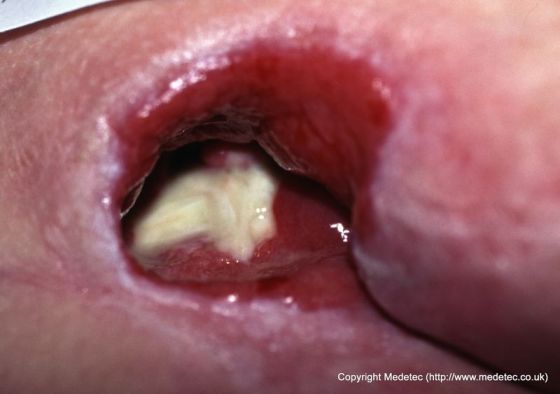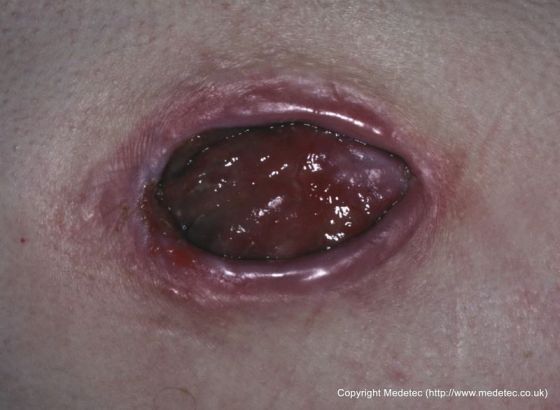Pressure Ulcers, Stages 3 and 4
Pressure ulcers are localized areas of tissue necrosis that typically develop when soft tissue is compressed between a bony prominence and an external surface for a long period of time. Stage 3 pressure ulcers involve full-thickness skin loss potentially extending into the subcutaneous tissue layer. Stage 4 pressure ulcers extend even deeper, exposing underlying muscle, tendon, cartilage or bone.
Symptoms of Stage 3 and Stage 4 Pressure Ulcers
Stages 3 and 4 pressure ulcers have deeper involvement of underlying tissue with more extensive destruction. Stage 3 involves the full thickness of the skin and may extend into the subcutaneous tissue layer; granulation tissue and epibole (rolled wound edges) are often present. At this stage, there may be undermining and/or tunneling that makes the wound much larger than it may seem on the surface. Stage 4 pressure ulcers are the deepest, extending into the muscle, tendon, ligament, cartilage or even bone.


Etiology
Pressure ulcers are accepted to be caused by three different tissue forces:
Prolonged pressure: In most cases, this pressure is caused by the force of bone against a surface, as when a patient remains in a seated or supine position for an extended period. When this pressure exceeds the tissue capillary pressure, it deprives the surrounding tissues of oxygen and can lead to tissue necrosis if left untreated.
Shear: This force is typically a result of the skin of a patient staying in one place as the deep fascia and skeletal muscle slide down, which can pinch off blood vessels and in turn lead to ischemia and tissue necrosis.
Friction: Friction is the opposing force to the shear force. This can cause microscopic and macroscopic tissue trauma, specifically when the patient is being moved across the support surface.
In addition, moisture from incontinence, perspiration or exudate can increase the coefficient of friction between the skin and the surface, making it more susceptible to friction damage. Increased moisture also can weaken the bonds between epithelial cells, resulting in skin maceration, which also makes the skin more susceptible to pressure, shear, and friction damage.
Risk Factors
- Immobility or limited mobility
- Spinal cord injury
- Diseases that affect blood flow such as diabetes or atherosclerosis
- Fragile skin
- Urinary or fecal incontinence
- Poor nutrition or dehydration
- Decreased mental awareness
- Obesity
- Neuropathy
- Fever
- Anemia
- Infection
- Ischemia
- Hypoxemia
- Neurological disease
Complications
Infection is the most common major complication of pressure ulcers. If the ulcer progresses far enough, it can lead to osteomyelitis (infection of the underlying bone) or sinus tracts, which themselves can be either superficial or connect to deeper structures.
Treatment of Stage 3 and Stage 4 Pressure Ulcers
The goal of treatment for stage 3 and 4 pressure ulcers, is to properly debride and dress the wound cavity, create or maintain moisture for optimal healing, and protect the wound from infection. The goal of properly unloading pressure from the area still applies. At these pressure ulcer stages, more emphasis should be placed on proper nutrition and hydration to support wound healing. If the extent of the pressure ulcer or other factors prohibit it from healing properly, surgery may be necessary to close the wound.
The following precautions can help minimize the risk of developing pressure ulcers in at-risk patients and to minimize complications in patients already exhibiting symptoms:
- Patient should be repositioned with consideration to the individual’s level of activity, mobility and ability to independently reposition. Q2 hour turning is the standard in many facilities, but some patients may require more or less frequent repositioning, depending on the previous list.
- Keep the skin clean and dry.
- Avoid massaging bony prominences.
- Provide adequate intake of protein and calories.
- Maintain current levels of activity, mobility and range of motion.
- Use positioning devices to prevent prolonged pressure bony prominences.
- Keep the head of the bed as low as possible to reduce risk of shearing.
- Keep sheets dry and wrinkle free.
References
Merck Sharp & Dohme Corp. Pressure Ulcers. The Merck Manual.
National Pressure Injury Advisory Panel. Prevention and Treatment of Pressure Ulcers/Injuries: Clinical Practice Guideline. The International Guideline 2019
Salcido R. Pressure Ulcers and Wound Care. Medscape Reference. http://emedicine.medscape.com/article/319284-overview#aw2aab6b2. Updated January 18, 2012. Accessed August 21, 2012.
Images copyright Medetec (www.medetec.co.uk). Used with permission.








Follow WoundSource
Tweets by WoundSource